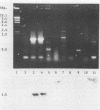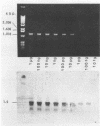Abstract
The polymerase chain reaction (PCR) and a radiolabeled oligonucleotide probe were used to specifically detect proteolytic and nonproteolytic Clostridium botulinum type B. Two synthetic primers deduced from the amino acid sequence data of type B neurotoxin were used to amplify a 1.5-kbp fragment corresponding to the light chain of the toxin. Although, nonspecific priming was observed when the PCR protocol was tested with other clostridial species, only the PCR product from C. botulinum type B isolates reacted with the radiolabeled internal probe. As little as 100 fg of DNA (approximately 35 clostridial cells) could be detected after only 25 amplification cycles.
Full text
PDF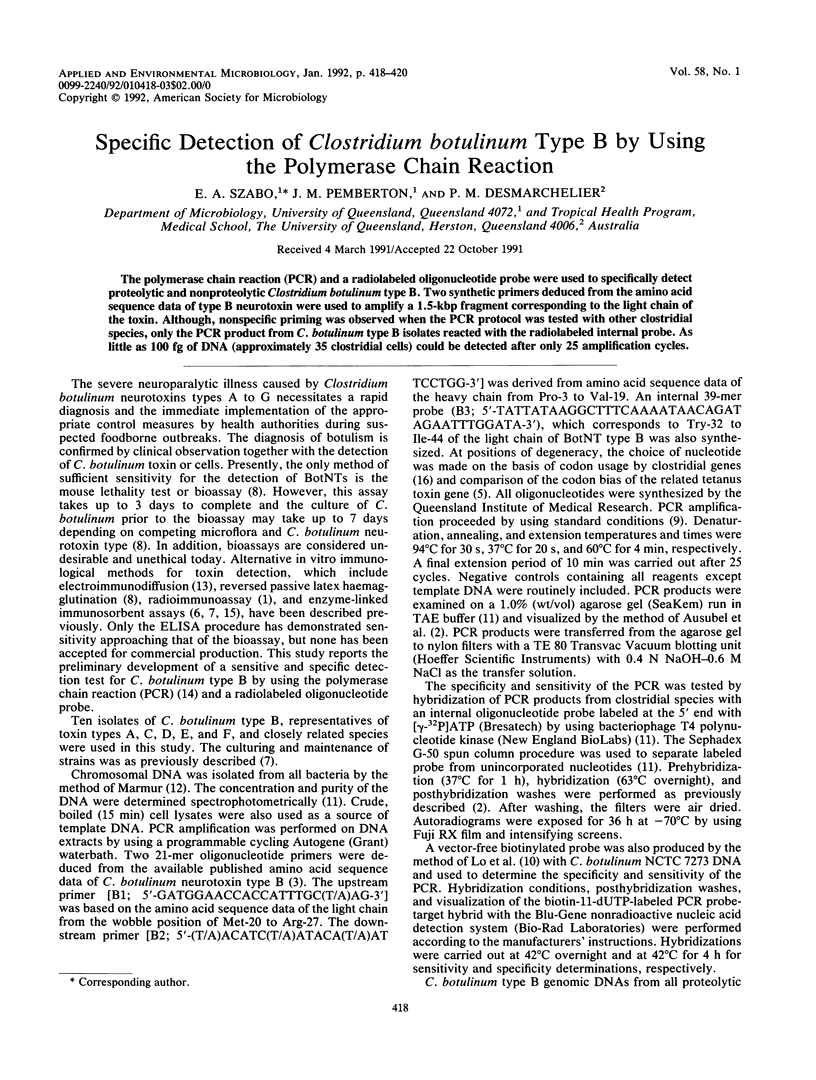
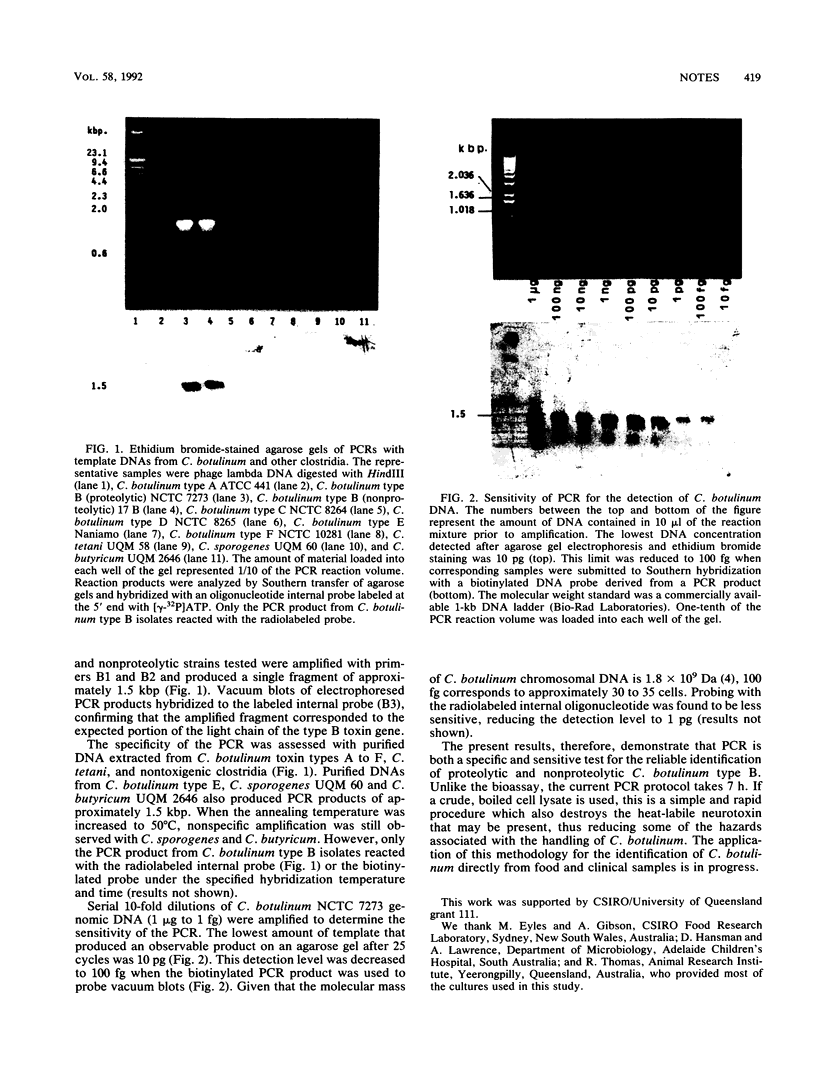
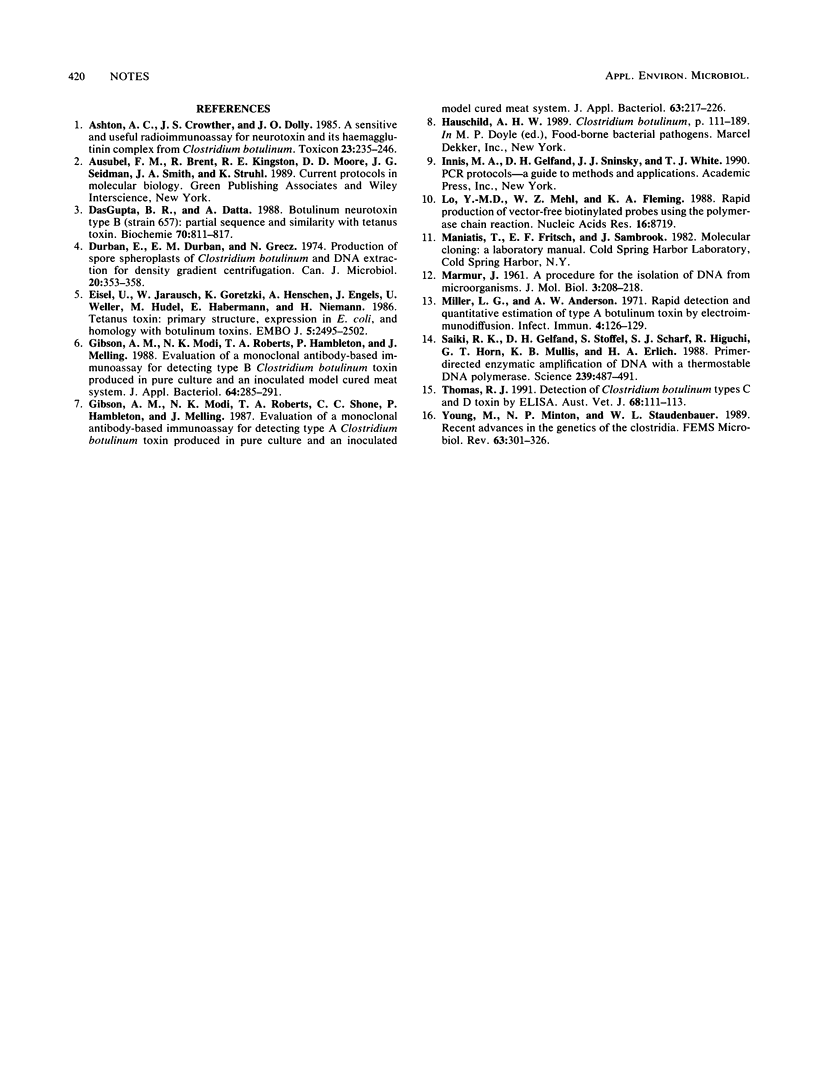
Images in this article
Selected References
These references are in PubMed. This may not be the complete list of references from this article.
- Ashton A. C., Crowther J. S., Dolly J. O. A sensitive and useful radioimmunoassay for neurotoxin and its haemagglutinin complex from Clostridium botulinum. Toxicon. 1985;23(2):235–246. doi: 10.1016/0041-0101(85)90146-1. [DOI] [PubMed] [Google Scholar]
- Dasgupta B. R., Datta A. Botulinum neurotoxin type B (strain 657): partial sequence and similarity with tetanus toxin. Biochimie. 1988 Jun;70(6):811–817. doi: 10.1016/0300-9084(88)90111-3. [DOI] [PubMed] [Google Scholar]
- Durban E., Durban E. M., Grecz N. Production of spore spheroplasts of Clostridium botulinum and DNA extraction for density gradient centrifugation. Can J Microbiol. 1974 Mar;20(3):353–358. doi: 10.1139/m74-054. [DOI] [PubMed] [Google Scholar]
- Eisel U., Jarausch W., Goretzki K., Henschen A., Engels J., Weller U., Hudel M., Habermann E., Niemann H. Tetanus toxin: primary structure, expression in E. coli, and homology with botulinum toxins. EMBO J. 1986 Oct;5(10):2495–2502. doi: 10.1002/j.1460-2075.1986.tb04527.x. [DOI] [PMC free article] [PubMed] [Google Scholar]
- Gibson A. M., Modi N. K., Roberts T. A., Hambleton P., Melling J. Evaluation of a monoclonal antibody-based immunoassay for detecting type B Clostridium botulinum toxin produced in pure culture and an inoculated model cured meat system. J Appl Bacteriol. 1988 Apr;64(4):285–291. doi: 10.1111/j.1365-2672.1988.tb01873.x. [DOI] [PubMed] [Google Scholar]
- Gibson A. M., Modi N. K., Roberts T. A., Shone C. C., Hambleton P., Melling J. Evaluation of a monoclonal antibody-based immunoassay for detecting type A Clostridium botulinum toxin produced in pure culture and an inoculated model cured meat system. J Appl Bacteriol. 1987 Sep;63(3):217–226. doi: 10.1111/j.1365-2672.1987.tb04939.x. [DOI] [PubMed] [Google Scholar]
- Lo Y. M., Mehal W. Z., Fleming K. A. Rapid production of vector-free biotinylated probes using the polymerase chain reaction. Nucleic Acids Res. 1988 Sep 12;16(17):8719–8719. doi: 10.1093/nar/16.17.8719. [DOI] [PMC free article] [PubMed] [Google Scholar]
- Miller C. A., Anderson A. W. Rapid detection and quantitative estimation of type A botulinum toxin by electroimmunodiffusion. Infect Immun. 1971 Aug;4(2):126–129. doi: 10.1128/iai.4.2.126-129.1971. [DOI] [PMC free article] [PubMed] [Google Scholar]
- Saiki R. K., Gelfand D. H., Stoffel S., Scharf S. J., Higuchi R., Horn G. T., Mullis K. B., Erlich H. A. Primer-directed enzymatic amplification of DNA with a thermostable DNA polymerase. Science. 1988 Jan 29;239(4839):487–491. doi: 10.1126/science.2448875. [DOI] [PubMed] [Google Scholar]
- Thomas R. J. Detection of Clostridium botulinum types C and D toxin by ELISA. Aust Vet J. 1991 Mar;68(3):111–113. doi: 10.1111/j.1751-0813.1991.tb00769.x. [DOI] [PubMed] [Google Scholar]
- Young M., Minton N. P., Staudenbauer W. L. Recent advances in the genetics of the clostridia. FEMS Microbiol Rev. 1989 Dec;5(4):301–325. doi: 10.1111/j.1574-6968.1989.tb03402.x. [DOI] [PubMed] [Google Scholar]



